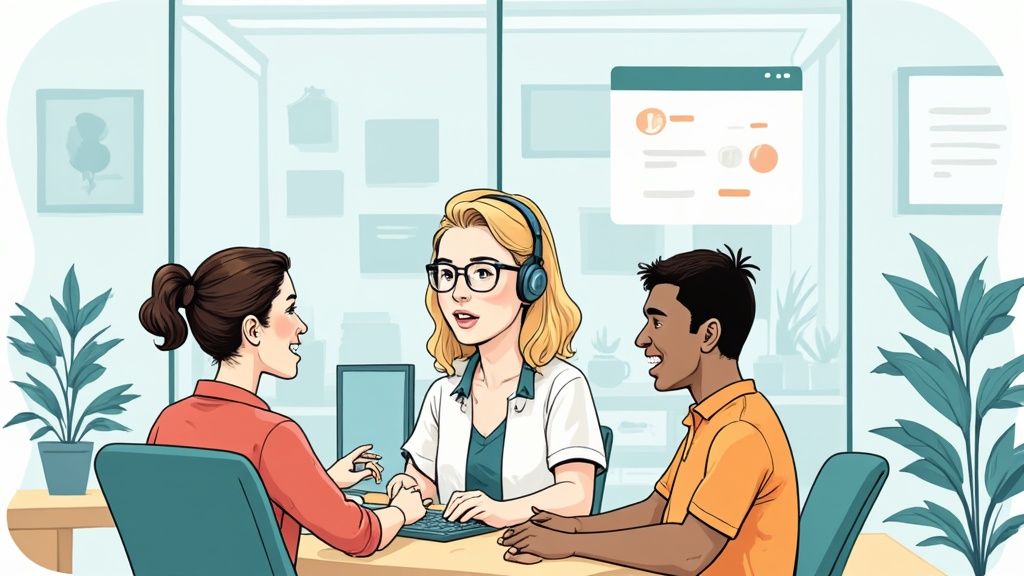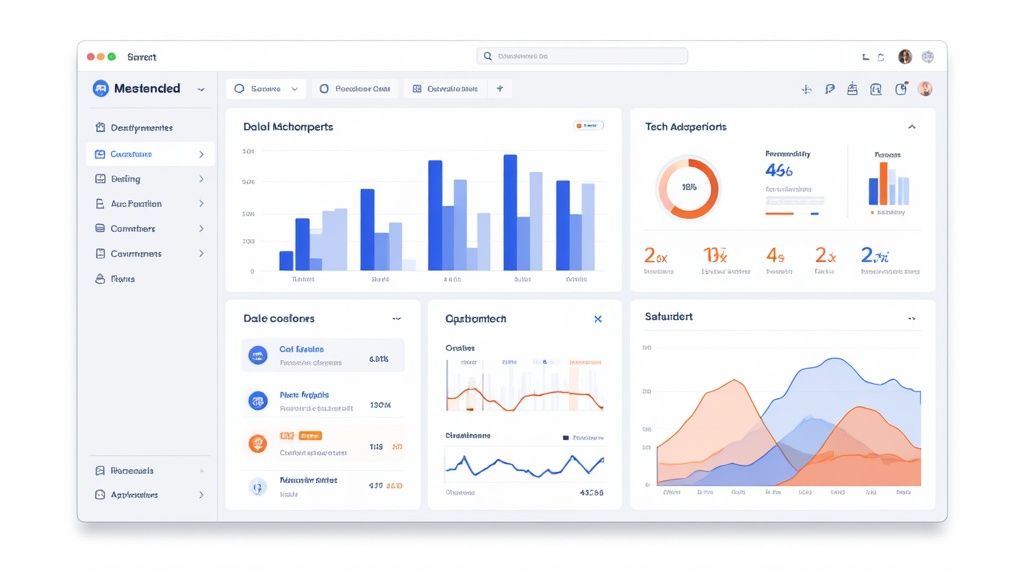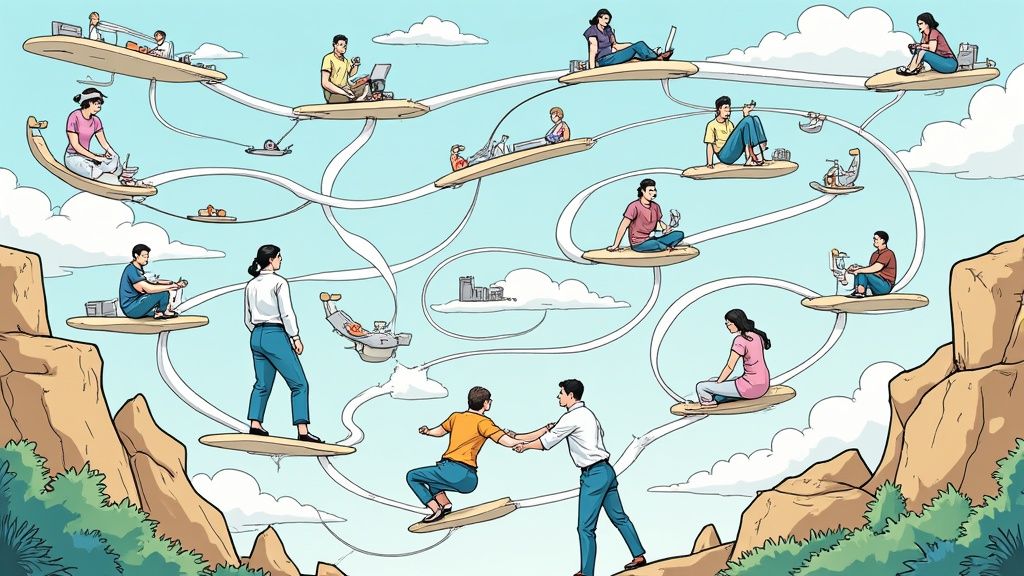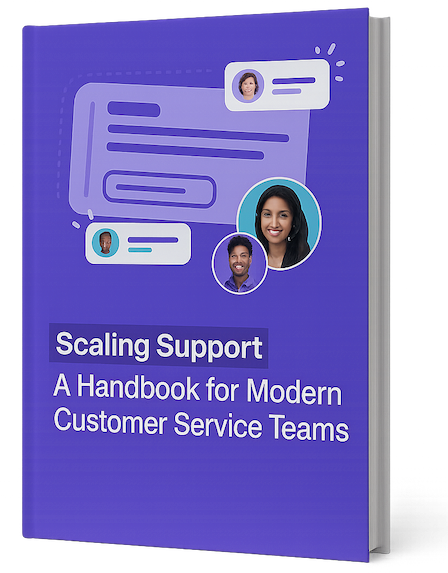Smart Customer Experience Management That Delivers Results
Customer experience management (CXM) has moved far beyond simply tracking basic customer metrics. Today, businesses understand CXM's direct impact on growth, customer loyalty, and revenue. This section examines how CXM drives business success and shapes key strategies.
The Growing Importance of Customer Experience Management
The numbers tell a compelling story about CXM's rise. The global CXM market, currently valued at USD 9,350 million, is set to grow at 15.53% annually from 2023 to 2032. This growth reflects how central CXM has become to modern business operations. In North America, where sophisticated business practices are common, CXM commands 41.01% market share – showing that companies recognize great customer experiences directly boost profits.
How CXM Drives Business Growth
Research consistently shows the clear connection between excellent customer experience and higher revenue. Studies reveal that 83% of businesses prioritizing customer satisfaction see stronger revenue growth. This makes sense – satisfied customers become loyal brand advocates, providing more sustainable growth than constantly chasing new customers. Companies that excel at customer experience grow 4-8% faster than market averages and generate 5.7 times more revenue than competitors who fall behind in CXM. These numbers prove that focusing on customer experience isn't optional – it's essential for financial success.
Creating Lasting Value Through CXM
A 16-year Watermark Consulting study shows just how much CXM matters over time. Companies leading in customer experience outperformed the S&P 500 by 260 points, while those lagging fell behind by over 175 points. The leaders generated returns 5.4 times higher than companies with poor customer experience. This proves that prioritizing customer experience creates lasting advantages. When businesses build loyalty through consistently great experiences, they create natural barriers against competitors and cement their market position. Taking this long-term view on CXM separates thriving companies from those struggling to keep up.
The Revenue Impact You Can't Ignore

When companies focus on delivering excellent customer experiences, their bottom line grows. Multiple studies show a direct connection between great customer service and financial performance. Let's explore exactly how strong customer experience management drives revenue growth.
Why CX Leaders Outperform the Competition
Companies that make customer experience a top priority consistently see better financial results than their peers. Research has found that businesses delivering superior customer experiences achieve 4-8% higher revenue growth compared to industry averages. This boost in performance comes from building real connections with customers – when people feel valued and well-served, they become loyal supporters who drive steady revenue through repeat business. Getting customer experience right creates a foundation for sustained financial success.
The Power of Customer Loyalty and Advocacy
Satisfied customers do more than just come back – they become active promoters of your business. Through positive word-of-mouth and online reviews, these loyal customers bring in new business at virtually no cost. The numbers back this up – companies with excellent customer experience generate 5.7 times more revenue than those who neglect it. This powerful multiplier effect shows why investing in customer experience is essential for long-term growth.
Measuring the ROI of CX Initiatives
To understand the real value of customer experience investments, companies track key performance indicators like:
- Customer lifetime value
- Reduction in customer churn
- Improved conversion rates
- Higher satisfaction scores
For instance, if you launch a new customer onboarding program, you can measure the change in customer lifetime value before and after implementation. Or you might track how your churn rate drops after improving response times. These concrete metrics help prove the business case for customer experience initiatives.
From Insights to Action: Implementing Effective CX Strategies
Understanding the revenue impact is just the start – companies need practical strategies to enhance customer experiences. This means creating reliable feedback loops, personalizing interactions, and quickly addressing issues before they grow. When done right, these improvements create a positive cycle – better experiences lead to happier customers who spend more and stay longer. The key is not just measuring customer experience, but actively working to make it better.
Building Long-Term Value Through Customer Experience
Customer experience management does more than just make customers happy – it creates real financial value over time. Through examining key research and real-world examples, we can see how focusing on customer experience drives business growth and market leadership.
The Watermark Consulting Study: A Powerful Case for CXM
A 16-year study by Watermark Consulting shows clear evidence connecting customer experience to financial performance. By tracking stock performance of public U.S. companies, they found that businesses excelling at customer experience outperformed the S&P 500 Index by 260 points.
This major performance gap shows that consistently delivering great customer experiences creates measurable business value. Companies that made customer experience a priority built stronger competitive positions and generated better returns for shareholders.
Laggards Fall Behind: The Cost of Neglecting CXM
The study revealed a stark contrast – companies with poor customer experience scores underperformed the S&P 500 by more than 175 points. This shortfall highlights the real costs of not making customer experience a priority.
Consider two retail competitors. One invests heavily in staff training, smooth online shopping, and quick problem resolution. The other cuts corners on service to reduce costs. Over time, the customer-focused retailer attracts more loyal customers and grows revenue, while the cost-focused competitor loses market share.
The Competitive Edge: Building Lasting Customer Relationships
The performance gap between leaders and laggards in customer experience, with leaders seeing 5.4 times greater returns, shows how customer focus creates real competitive advantages. Companies that take a long-term view of customer experience pull ahead of those focused only on short-term gains.
Frameworks for Sustained CX Excellence
Leading companies maintain their edge through proven frameworks focused on:
- Customer-Centric Culture: Making customer needs the top priority in decisions across the organization
- Continuous Feedback Loops: Getting customer input to spot and fix problems early
- Employee Empowerment: Giving staff the tools and authority to solve customer issues
- Data-Driven Optimization: Using analytics to understand behavior and personalize experiences
These frameworks help companies create strong customer relationships that drive growth. Focusing on customer experience isn't just good practice – it's essential for long-term success in competitive markets.
Mastering the Economics of Customer Relationships

Understanding how to balance new customer acquisition with existing customer retention is key to building sustainable business growth. This means carefully examining the costs and returns involved in managing customer relationships through their entire lifecycle. Let's explore the real economic impacts of different customer experience strategies.
The High Cost of Customer Acquisition
Getting new customers requires major investments in marketing, sales processes, and initial onboarding support. Studies show that bringing in a new customer typically costs 5-25 times more than keeping a current one. For example, if retaining a customer costs $100, acquiring a new one could cost anywhere from $500-$2500. These stark numbers highlight why keeping your existing customers happy through great experiences brings much better returns than constantly chasing new business.
Retention: The Cornerstone of Profitability
Focusing on customer experience pays off directly in customer retention and profits. Satisfied customers make repeat purchases and often become vocal supporters who bring in new business through word-of-mouth. When customers feel valued, they stay longer and spend more, creating reliable revenue streams without the high costs of acquisition marketing. Strong retention through consistently positive experiences helps build a stable foundation for growth.
Customer Journey Mapping: Optimizing for Value
Understanding and improving the end-to-end customer experience requires detailed journey mapping to spot both problems and opportunities. By tracking each interaction point, companies can proactively address issues before they impact satisfaction. This focused approach to optimizing experiences typically boosts revenue 10-15% while reducing service costs 15-20%. The data clearly shows that investing in customer experience improvements generates measurable financial benefits.
Building Loyalty Programs That Drive Results
Well-designed loyalty programs encourage repeat business while providing valuable data about customer preferences and behaviors. Rather than just offering generic rewards, effective programs use tiered benefits that increase with customer engagement. For instance, a program might start with basic perks for new members but add exclusive benefits at higher spending levels. This creates motivation to deepen the relationship while helping companies better understand and serve their most valuable customers.
The Power of Feedback Loops
Regularly gathering and acting on customer feedback helps companies stay aligned with changing needs and expectations. Simple post-interaction surveys provide insights for meaningful improvements. When companies demonstrate they value and respond to feedback, it strengthens loyalty and provides direction for optimizing products, services and experiences. Creating these feedback loops transforms customer experience from reactive problem-solving into proactive relationship building focused on long-term growth.
Using Personal Service To Stand Out

Alongside loyalty programs and feedback channels, personalized service has become essential for managing customer experience. Nearly 90% of customers now expect interactions customized to their needs. This goes beyond adding a customer's name to emails – it means shaping every touchpoint around individual preferences and behaviors. Companies are actively adapting their approaches to meet these rising expectations.
Why Personal Service Matters
When companies tailor experiences to each customer, it creates real business value. Think about getting product suggestions that match your past purchases, or seeing content curated to your specific interests. This level of personal attention helps build stronger connections with customers. Research shows that companies focusing on customer-centric operations, including personalization, see 60% higher profits compared to those that don't. The numbers clearly show how personalized service drives both customer satisfaction and business results.
Making Personalization Work at Scale
While the benefits are clear, delivering personalized service to a large customer base requires careful planning and execution. Success depends on using customer data thoughtfully to create meaningful interactions.
-
Data Collection and Segmentation: Start by gathering key customer information like demographics, purchase history and browsing patterns. Group customers with similar traits to enable more focused personalization. For example, a clothing store might segment customers based on style preferences and sizes.
-
Targeted Content and Offers: Use your customer segments to deliver relevant content and promotions across different channels. Send specific product recommendations instead of generic sales pitches through email, web pages and social media.
-
Personal Communication Style: Match your tone and approach to different customer groups. Some respond better to casual, friendly messages while others prefer more formal communication. These small details enhance the personal feel.
-
Dynamic Website Content: Show website content tailored to each visitor. This could include product suggestions based on browsing history or customized navigation. Making the website experience more relevant keeps visitors engaged.
Tracking What Works
Measuring results helps optimize your personalization efforts and proves their value. Key metrics to watch include:
-
Conversion Rates: See how personalization affects specific actions like cart additions and purchases.
-
Click-Through Rates: Track engagement with personalized emails and website content across customer segments.
-
Customer Lifetime Value: Monitor how personalization influences long-term customer relationships and repeat business.
Regular analysis of these metrics lets you refine your approach over time. The data shows what resonates with different customer groups and where to focus future improvements. It also helps make the case for continued investment in personalization by demonstrating clear business impact. Most importantly, tracking results ensures your efforts actually improve the customer experience.
Creating Your Customer Experience Action Plan

Understanding your customers through data analysis is essential, but putting those insights into practice is what truly matters. Let's look at how to build an action plan that gets real results. Here's a practical framework to assess your current state, find quick improvements, and create lasting programs that boost your business.
Assessing Your Current Customer Experience Landscape
Start by mapping out every interaction customers have with your business – from their first website visit through post-purchase support. This gives you a clear picture of what's working and what isn't. For example, you might find that customers love browsing your site but get frustrated during checkout. Customer journey mapping lets you spot these pain points and figure out what needs fixing first.
Identifying Quick Wins and Long-Term Strategies
Once you understand your current state, you can prioritize improvements. Focus first on "quick wins" – small changes that make a big difference right away. This could mean simplifying your checkout process or responding faster to customer questions. Quick wins show customers you care about improving their experience. At the same time, plan bigger projects like loyalty programs or self-service tools that take more time but create lasting advantages.
Building a Sustainable CX Program
Making lasting improvements requires structure. Here's what you need:
-
Clear Goals: Set specific, measurable targets. Instead of just saying "make customers happier," aim for "increase satisfaction scores by 10 points in six months."
-
Key Metrics: Track the numbers that matter most, like satisfaction scores, customer retention, and lifetime value. These show whether your changes are working.
-
Customer-First Culture: Great service comes from the whole company, not just support teams. Make customer needs a priority in every decision.
-
Regular Feedback: Keep asking customers what they think and use their input to improve. This helps you stay ahead of problems and meet changing needs.
Overcoming Implementation Challenges
Watch out for common roadblocks like:
-
Scattered Data: Customer information often lives in different systems. Work on connecting these to get a complete view of customer interactions.
-
Limited Resources: You'll need money for tools, training, and staff. Show leaders how these investments pay off through better results.
-
Employee Hesitation: Some staff may resist new ways of working. Help them understand the benefits through clear communication and training.
By tackling these challenges head-on and following a solid plan, you'll create better experiences that keep customers coming back. A strong action plan is key to standing out in today's market.
Ready to streamline your customer support operations and improve customer satisfaction? Start your free trial of SupportMan today – no credit card required!


